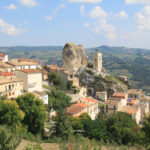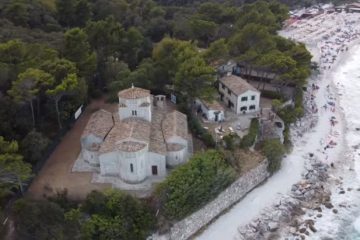What to see in Liguria
“I have found at last a land that soothes my soul, makes it sweet and content with life.”
I think this thought by Lord Byron, perfectly describes the beauty of Liguria, land of poets, sailors and artists, land of basil and olive trees, fishing villages and terracing.
Liguria is a kind of treasure chest of beauty, concentrated in a few miles. The scents, the colors, the sound of the wind and the sea, make it stay in your heart.
CITIES:
Liguria has five main cities.
Genoa: La Superba, the city of Fabrizio de Andrè, who wonderfully described it in his songs, to which Paolo Conte dedicated one of his most beautiful songs, and which even Chekhov in The Seagull, has one of his characters say ” Genoa is the most beautiful city in the world,” and how right Chekhov was, La Superba is without a doubt one of the most enchanting and enchanting cities you can visit: its harbor, its carrugi, its people and the beach of Boccadasse, with the picturesque palazzetti and the famous attic near the blue from where “Ciacola,” Gino Paoli’s famous Gatta, looked out.
An iconic place in Genoa, Boccadasse is one of the city’s seaside villages, with its colorful palazzetti, moored boats and typical little restaurants where you can enjoy the delicacies of Ligurian cuisine, making it an unmissable destination on a trip to this unique city.
From this enchanting corner, you can take a nice walk along Corso Italia, admiring the many Art Nouveau palaces, and arrive in the center where other splendors of the greatness of this seaside city await.
Using the bike path that runs along Corso Italia from Boccadasse, one arrives at Piazza De Ferrari, Genoa’s main square, located in the ancient sestiere of Portoria. This square is overlooked by some of the most important buildings such as the Carlo Felice Theater, the Palace of the Region of Liguria and those of the Linguistic Academy and the New Stock Exchange.
A few steps away from here, in Porta Soprana, is the House of Christopher Columbus, and also a short distance away is the Ducal Palace, the former seat of the Doge, now a museum that hosts exhibitions of great interest. The Mannerist-style palace was built at the height of Genoa’s greatness and its maritime dominance in the Mediterranean.
Continuing to stroll and stopping at Piazza Stella to see the Duomo, one arrives at Piazza Caricamento and the old harbor, designed by Renzo Piano in the context of which is the aquarium(with the largest biodiversity in Europe) and from here a succession of interesting sights such as The Galata(the museum of the sea), the Biosphere and the Bigo and the Lantern, the city’s symbolic lighthouse.
Still a very short distance away, the wonders continue with historic palaces, many of them museum sites, housing paintings by Caravaggio, Rubens, and Van Dyck, such as Palazzo Bianco Palazzo Rosso and Palazzo Tursi, which form the Strada Nuova Museums. Also worth a visit is the MEI: Museum of Italian Emigration.
Also in the historic center, you can visit the famous carrugi and Via Del Campo, the historic stores, the Staglieno cemetery, and the Castelleto esplanade, where you can reach by the famous Art Nouveau elevator and from which you can enjoy a breathtaking view of this fantastic city.
Just outside the city are parks, such as that of the city walls, the Nervi park and that of the Pallavicini palace in Pegli.
Everywhere in Genoa there is no shortage of restaurants, trattorias to enjoy the and typical little places to sample the many culinary delights, among all the famous pasta pesto and potatoes.
IMPERIA: Imperia is a city in western Liguria, very special because having been created by the merger of Oneglia and Porto Maurizio in the 1920s, it has two historic centers and two ports.
Oneglia is the beating heart of the city, here are the commercial activities, the old fishermen’s houses and many small restaurants; the clown museum in Villa Grock is worth a visit.
Porto Maurizio, on the other hand, is the oldest area, here you will find the largest church in Liguria, the basilica of San Maurizio and the navigation museum.
LA SPEZIA: Overlooking the Gulf of Poets, this town has a beautiful pedestrian zone and a waterfront promenade with fantastic views. Towering over all the buildings in the town is the Castle of San Giorgio, a fortress formed by two buildings, now a museum that in addition to housing the archaeological collection hosts exhibitions and events.
SAVONA: a little gem, now a tourist destination especially for cruise passengers, has a nice tourist district located in the Darsena area. Worth seeing in Savona is the Leon Pancaldo Tower, a symbol of the city known as the Torretta, along with the Brandale Tower. For Shopping you should stroll in Via Paleocapa, with its retro arcades and in the very old Via Pia, also famous for its typical trattorias.
THE COAST:
The Ligurian coast certainly needs no introduction, known throughout the world and already the destination of the Grand Tour so beloved by the artists of the 1800s, it certainly has some of the most beautiful areas in Italy.
From west to east we have: the Riviera of Flowers, among the most famous cities Sanremo and Ventimiglia; the Riviera of the Palms with Noli and Spotorno; Portofino and The Gulf of Tigullio, surely one of the most sought-after and chic areas of the Mediterranean; the Cinque Terre, which Eugenio Montale described as a “place of the Soul finally the Gulf of Poets: great poets such as Lord Byron, D.H Laurence and Virginia Wolf stayed here. The Ligurian coast can be enjoyed all year round because there are all kinds of tourism here, beach tourism of course, but also cultural tourism, relaxation tourism, hiking tourism, and gastronomic tourism.
Liguria has as many as 6 marine protected areas: Cinque Terre, Portofino, Porto Venere, Bergeggi, Gallinara Island, and Capo Mortola.
THE VILLAGES:
Liguria has as many as 22 villages included in the official list of The Most Beautiful Villages in Italy, here are some of them:
If Portofino and Porto Venere need no introduction, Tellaro is certainly less well known, but certainly no less charming; located in the Gulf of Poets, this small colorful village sits on a rocky rise and to get there by car there is only one road that goes through Lerici; those who love to walk will be able to get there along various paths.
Triora is one of the most mysterious villages in Italy; in fact, it is known as the town of the Witches, this small village lost in the Ligurian Apennines was in fact the site of the most famous witch trial in Italy in the 16th century. Often shrouded in fog and inhabited by few people, it is definitely a destination not to be missed.
Colletta di Castelbianco, on the other hand, is a stone hamlet of medieval origin, which, however, thanks to special restoration work has become the first telematic hamlet in Italy, where you can work away from the chaos of the city. The stone houses with colorful doors are equipped with the latest technology. These types of hamlets are modeled after American televillages.
GASTRONOMY:
Ligurian gastronomic products make your mouth water just thinking about them; this is the home of pesto and his majesty basil, the famous terraced cultivations give way to the olive trees that produce the extra virgin D.O.P olive oil, and what about the famous Taggiasche olives and the focaccia of Recco, the Frandura of Montalto Ligure (a traditional dish made with flour) or the farinata of Savona, the wines of the Cinque Terre and the Ponente.
Irma
LATEST POSTS



















